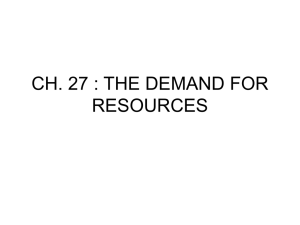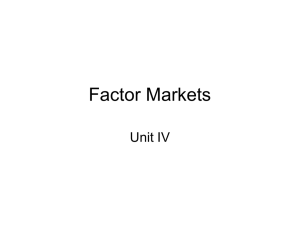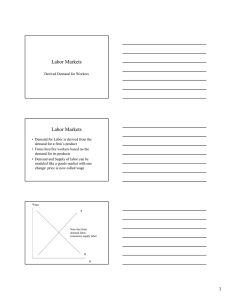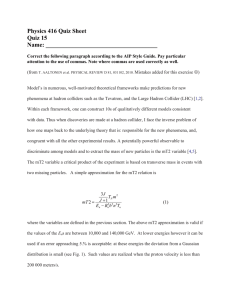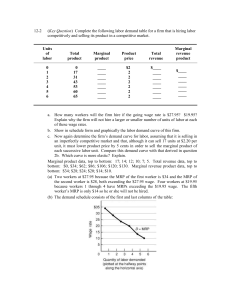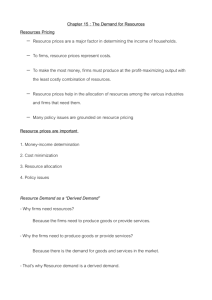Economics Exam Questions: Resource Pricing & Labor Demand
advertisement
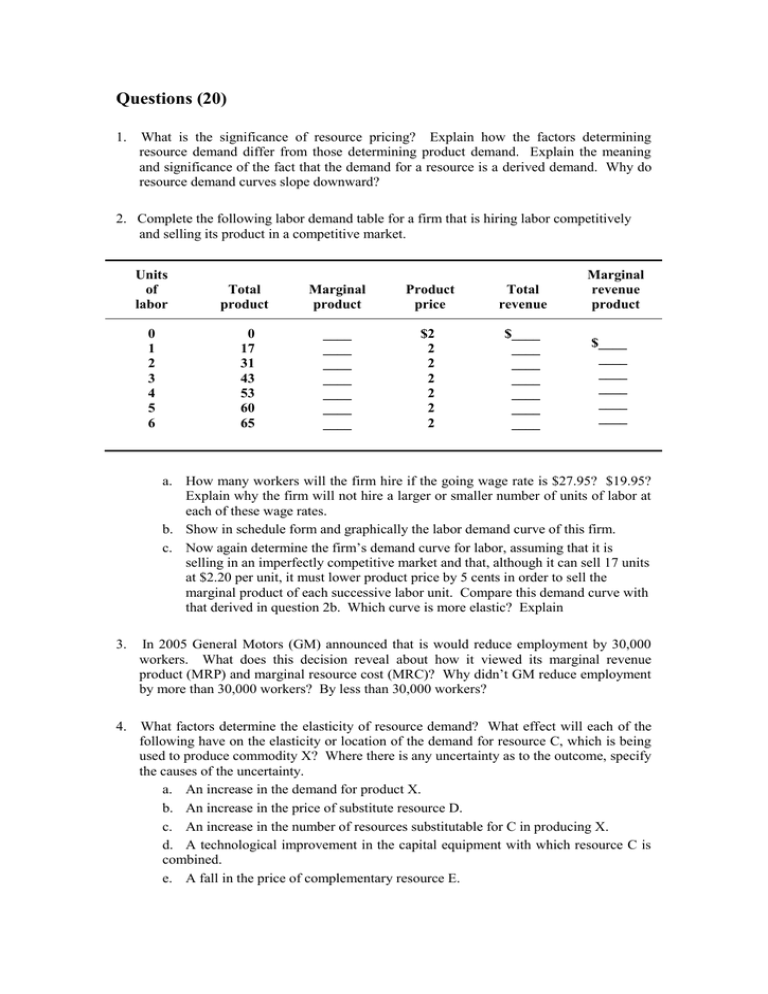
Questions (20) 1. What is the significance of resource pricing? Explain how the factors determining resource demand differ from those determining product demand. Explain the meaning and significance of the fact that the demand for a resource is a derived demand. Why do resource demand curves slope downward? 2. Complete the following labor demand table for a firm that is hiring labor competitively and selling its product in a competitive market. Units of labor Total product Marginal product Product price Total revenue 0 1 2 3 4 5 6 0 17 31 43 53 60 65 ____ ____ ____ ____ ____ ____ ____ $2 2 2 2 2 2 2 $____ ____ ____ ____ ____ ____ ____ Marginal revenue product $____ ____ ____ ____ ____ ____ a. How many workers will the firm hire if the going wage rate is $27.95? $19.95? Explain why the firm will not hire a larger or smaller number of units of labor at each of these wage rates. b. Show in schedule form and graphically the labor demand curve of this firm. c. Now again determine the firm’s demand curve for labor, assuming that it is selling in an imperfectly competitive market and that, although it can sell 17 units at $2.20 per unit, it must lower product price by 5 cents in order to sell the marginal product of each successive labor unit. Compare this demand curve with that derived in question 2b. Which curve is more elastic? Explain 3. In 2005 General Motors (GM) announced that is would reduce employment by 30,000 workers. What does this decision reveal about how it viewed its marginal revenue product (MRP) and marginal resource cost (MRC)? Why didn’t GM reduce employment by more than 30,000 workers? By less than 30,000 workers? 4. What factors determine the elasticity of resource demand? What effect will each of the following have on the elasticity or location of the demand for resource C, which is being used to produce commodity X? Where there is any uncertainty as to the outcome, specify the causes of the uncertainty. a. An increase in the demand for product X. b. An increase in the price of substitute resource D. c. An increase in the number of resources substitutable for C in producing X. d. A technological improvement in the capital equipment with which resource C is combined. e. A fall in the price of complementary resource E. f. 5. A decline in the elasticity of demand for product X due to a decline in the competitiveness of product market X. Suppose the productivity of labor and capital are as shown in the accompanying table. The output of these resources sells in a purely competitive market for $1 per unit. Both capital and labor are hired under purely competitive conditions at $3 and $1, respectively. Units of capital MP of capital Units of labor MP of labor 1 2 3 4 5 6 7 8 24 21 18 15 9 6 3 1 1 2 3 4 5 6 7 8 11 9 8 7 6 4 1 1/2 a. What is the least-cost combination of labor and capital to employ in producing 80 units of output? Explain. b. What is the profit-maximizing combination of labor and capital the firm should use? Explain. What is the resulting level of output? What is the economic profit? Is this the least costly way of producing the profit-maximizing output? 6. In each of the following four cases, MRPL and MRPC refer to the marginal revenue products of labor and capital, respectively, and PL and PC refer to their prices. Indicate in each case whether the conditions are consistent with maximum profits for the firm. If not, state which resource(s) should be used in larger amounts and which resource(s) should be used in smaller amounts. a. MRP L $8; PL $4; MRP C $8; PC $4 b. MRP L $10; PL $12; MRP C $14; PC $9. c. MRP L $6; PL $6; MRP C $12; PC $12. d. MRP L $ 22; PL $26; MRP C $16; PC $19.

